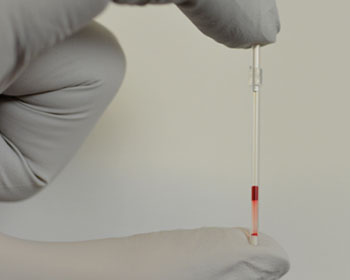Novel Diagnostic Test Developed for Sickle Cell Disease
By LabMedica International staff writers
Posted on 09 Sep 2014
Researchers have developed a simple, rapid, low-cost test for sickle cell disease (SCD) that could enable large-scale global screening also of children in underprivileged regions, such as those in Africa and India.Posted on 09 Sep 2014
A team led by Harvard University (Cambridge, MA, USA) postdoctoral fellow Ashok Kumar, PhD, and Prof. George Whitesides have developed a low-cost, novel test for SCD that provides results in just 12 minutes. “The tests we have today work great, they have a very high sensitivity,” said Dr. Kumar, “But the equipment needed to run them costs in the tens of thousands of dollars, and they take hours to run. That’s not amenable to rural clinics, or even some cities, where the medical infrastructure isn’t up to the standards we see in the US.” Although extensive analysis will be needed to determine whether the test is accurate enough to use in the field, when run against over 50 known clinical samples — 26 positive and 26 negative — it showed good sensitivity and specificity.

Image: Scientists have developed a simple new test for sickle cell disease that provides results in just 12 minutes and costs as little as USD 0.5 — far simpler, faster, and cheaper than current tests (Photo courtesy of Dr. A. Kumar and Harvard University).
A chance meeting with Dr. Thomas Stossel, MD at Harvard-affiliated Brigham and Women’s Hospital had steered Dr. Kumar into focusing on SCD. “Initially, we started off working on malaria, because we thought when parasites invaded the cells, it would change their density,” he said, “But when I met Tom Stossel on a panel at the Harvard Medical School, he said, ‘You need to work on sickle cell.’ He’s a hematologist by training and has been working with a nonprofit in Zambia for the past decade, so he’s seen the need from the lack of a diagnostic tool.”
The method design is simple and works by connecting two long-understood principles. First, sickle cell red blood cells (RBCs) are denser than normal RBCs; second, many polymers, when mixed in water, automatically separate into layers ordered by density. Conventional methods to separate cells by density have relied on layering liquids with different density by hand. The new insight was to use the self-forming density layers. “When you mix the polymers with water, they separate just like oil and water,” said Dr. Kumar, “Even if you mix it up, it will still come back to those layers.” When the test was run with infected blood, the results were unmistakable. While healthy RBCs settled in the tubes at specific levels, the dense RBCs from blood infected with sickle cell settled significantly lower. The band of RBCs could clearly be seen by eye.
Next, “We wanted to make the test as simple as possible,” Dr. Kumar explained, “The idea was to make it something you could run from just a finger prick. Because these gradients assemble on their own, that meant we could make them in whatever volume we wanted, even a small capillary tube.” The design they chose is barely larger than a toothpick. In the field, running the test is as simple as uncapping the tube, pricking a patient’s finger, and allowing the blood to wick into the tube.
“There were studies recently that showed in sub-Saharan Africa between 50%-90% of the children born with sickle cell disease die before the age of 5,” said Dr. Kumar, “Whereas in the US people don’t die from this disease as children, they can still live a full life. So my hope is that if this test is effective, it can make [at least] some small dent in those numbers.”
The test is described in the journal Proceedings of the National Academy of Sciences of the United States of America (PNAS), September 2, 2014, online before print.
Related Links:
Harvard University














